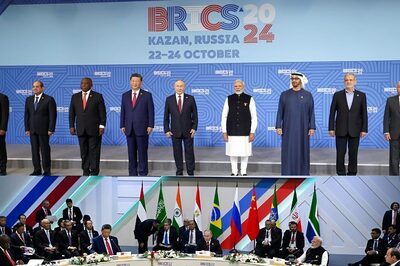
views
The air quality index in parts of Delhi rapidly worsened on Saturday due to unfavourable meteorological conditions such as low temperature and slow wind speed, taking the AQI to a ‘hazardous’ level with a reading of 556. The overall AQI in Delhi, however, is at 386 in the ‘ Very Poor’ category. The air pollution levels are expected to improve from November 29 due to high wind speed.
From Friday’s 406, the AQI alarmingly jumped one category on Saturday. Local surface winds are likely to increase slightly for the next two days dispersing pollutants leading to a slight improvement in the air pollution, but the AQI will be in the ‘higher end of very poor’ category. The share of stubble burning in Delhi’s PM2.5 pollutants is eight per cent.
The air quality in the national capital has remained ‘very poor’ or ‘severe’ on most of the days in November so far. Delhi recorded the lowest air pollution levels in terms of the 24-hour average quality index on November 1 (AQI 281) and November 23 (AQI 290).
“Mixing layer height and wind are the dominant factors controlling air quality. From November 29 significant improvement in AQI is expected due to high wind speed,” said the Ministry of Earth Sciences’ air quality monitor SAFAR. Neighbouring Faridabad (423), Ghaziabad (378), Greater Noida (386), Gurgaon (379) and Noida (394) also saw a dip in air quality on Friday evening.
The United Residents Joint Action (URJA) of Delhi, a consortium of more than 2,500 resident welfare associations (RWAs) in the national capital, meanwhile on Friday launched a citizen driven monitoring campaign to accelerate the fight against air pollution.
Representatives from 13 identified hotspots of Delhi will work closely with the Municipal Corporations of Delhi and help report incidents of waste burning, debris dumping or other violations in their area.
Pre- and post-Diwali, Delhi has consistently witnessed ‘very poor’ and ‘severe’ Air Quality Index (AQI).
In 2019, Central Pollution Control Board (CPCB) and Delhi Pollution Control Committee (DPCC) had identified Rohini, Dwarka, Okhla Phase-2, Punjabi Bagh, Anand Vihar, Vivek Vihar, Wazirpur, Jahangirpuri, RK Puram, Bawana, Mundka, Narela and Mayapuri as hotspots in the city.
The hotspots have an annual average PM10 exceeding 300 Ig/m3 and PM2.5 concentration of more than 100 Ig/m3. While the CPCB safety standards are 60 Ig/m3 and 40 Ig/m3 for PM10 and PM2.5, respectively.
“Good”, “satisfactory” and “moderate” air quality days together increased from 159 in 2018 to 198 up until November 23, 2021, according to a Delhi Department of Environment report.
“‘Good’, ‘satisfactory’ and ‘moderate’ days together increased from 159 in 2018 to 182 in 2019, 227 in 2020, and 198 in 2021. ‘Poor’,’ very poor’ and ‘severe days’ together reduced from 206 in 2018 to 183 in 2019 and 139 in 2020 and 129 in 2021,” the report reads.
Delhi Environment Minister Gopal Rai has repeatedly emphasised that the majority of the national capital’s air pollution is due to stubble burning in the neighbouring states of Punjab and Haryana, whereas Delhi’s own sources of pollution are very minimal or limited.
(With agency inputs)
Read all the Latest India News here




















Comments
0 comment